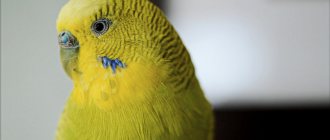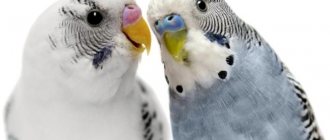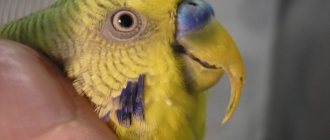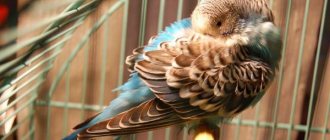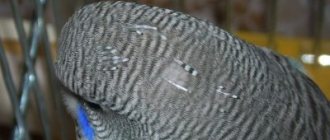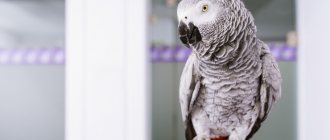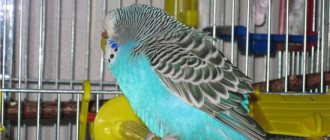Normal wax color in a parrot
Before you panic, you should know for sure that the wax has changed color due to some disease, and not for natural reasons. Brown nose color is present in female budgerigars. In this case, the chick is born with a blue or pink wax. The light shade gradually turns into a brown color and indicates that the individual has matured and is ready for nesting. The color of the beak, nose and plumage changes when the bird is over 35 days old. The young chick's beak also has a black stripe along the upper beak. This mark is present only in birds up to 1.5 months old. Then, during normal development, the beak becomes lighter and the mark disappears. In normal health, the bird may have a brown beak and wax, but in this case you need to pay attention to the appearance of the nose. It should be dry or slightly damp, smooth, without flaking fragments. The color is uniform throughout the wax. Deterioration of condition, untidiness, exudation - all these are signs of a sick bird.
Prevention of wax diseases
When you get a budgie, remember that you will need to care for it for the rest of its life. And the better you do this, the longer the pet will live, delighting you with its cheerful chirping and healthy appearance. Simple steps will help you avoid many diseases in birds, including their wax:
- Clean the cage regularly and thoroughly (the tray - daily, the cage itself - at least once every 3-4 days);
- Wash the sippy cup and feeders daily;
- Disinfect toys and perches weekly;
- feed variedly, not forgetting about mineral and vitamin supplements;
- the food must be of high quality, do not skimp on your pet’s health;
- Treat branches of bushes and trees, as well as grass, brought from the street well before offering them to the bird (soak in cold water for 12 hours, then thoroughly clean the branches with a brush and pour boiling water over them twice; it is advisable to also pour boiling water over the grass);
- Monitor your pet’s health, examine its paws, nose and feathers from time to time so as not to miss the appearance of alarming symptoms.
If you notice any changes in the cere of your budgerigar, do not neglect contacting a specialist. You should not try to treat the bird yourself, because at home it is not always possible to correctly determine the diagnosis. Timely treatment will help quickly restore your pet’s health.
Watch in this video how the sex and age of budgerigars are determined by the cere:
The main reasons for changing nose color
Among the main reasons why a parrot has a brown cere are the following factors:
- Necrosis. With this disease, darkening of the bird's nose is observed. The disease is very serious for a small organism and can cause the death of a bird. A very dark brown or black growth forms on the nose. If the disease takes on an advanced form, the cere disappears completely. In females, additional symptoms such as peeling of the beak are observed; in males, the beak becomes black. Necrosis is caused by infectious diseases, as well as advanced forms of rhinitis and problems with blood circulation throughout the body. Treatment should begin from the initial stage. Large growths on the beak can only be removed surgically and a course of antibiotics is prescribed;
- Knemidocoptosis. The disease is well treated if detected at an early stage. Among the accompanying signs of this disease are the constant desire of the bird to scratch its beak on the bars of the cage or on objects, the upper beak changes color, and characteristic growths appear on the nose. The beak may crack and actively grow. A beak that is too long causes the parrot to have poor nutrition, since tissue growth does not allow it to capture food; pruning with nippers is required. Along with this, peeling of the paws is observed. The cause is scabies mites, which parasitize bone tissue. In the advanced stage, knemidocoptic mange engulfs the skin, the mites envelop the entire body of the bird, causing severe itching. Treatment with special drugs is required;
- Hyperkeratosis. If a parrot has a brown nose due to hyperkeratosis, then the cause is a hormonal imbalance in the body. This disease does not cause the death of the pet, but affects the ability to have offspring. The disease can be identified by the following symptoms: the beak and cere increase in size, the bridge of the nose becomes covered with dark spots and stripes, the parrot may be too active or too passive.
How to determine by the cere what a parrot is sick with
If a budgerigar's wax has slightly changed color and started to peel off, it most likely has an infectious disease.
A darkened cere, turning brown or even black, but retaining its uniform smooth structure, indicates overwork and stress.
In order to accurately make a diagnosis and timely identify more dangerous diseases that have identical visual manifestations on the wax, you should consult a doctor at the slightest change.
Treatment methods
If your parrot's beak has turned brown and accompanying symptoms are observed, you should seek help from an ornithologist. The doctor will conduct a visual examination, prescribe tests, then establish a diagnosis and prescribe effective treatment. Therapy directly depends on the cause of the discoloration of the beak. You can improve your pet's condition through diet. Particular attention is paid to vitamin A. It is advisable to introduce peaches, apricots, carrots, and tomatoes as top dressing. A calcium stone must be installed in the cage. If ticks are found, the following treatment is carried out:
- the cere must be lubricated several times a day with Aversectin ointment using a cotton swab;
- parrot's paws are also subject to treatment;
- if necessary, the beak is trimmed using nippers;
- Daylight hours are shortened by two hours so that the bird can rest more and gain strength.
In severe cases, treatment with antibiotics is required. Proper diet and compliance with living conditions are the main aspects of maintaining the health of your feathered friend.
Diseases of budgies
ORNITHOLOGY LIBRARY NEW BOOKS SPECIES OF BIRDS LINKS SITE MAP ABOUT THE SITEBudgerigars kept in cages and aviaries are highly resistant to various diseases. Despite this, they can still get sick from diseases that are observed in all birds living in the wild. Recently, we have had to deal with special diseases caused by unfavorable living conditions for budgerigars, and these diseases are rarely observed in birds living in the wild.
It is not easy to recognize diseases, especially in their initial stages, so fanciers should carefully monitor the behavior of their birds and record the changes occurring in them, because this data can serve as the basis for determining the correct diagnosis.
Many lovers who keep budgerigars try to independently treat sick birds with home remedies and only after trying a number of medications on them do they seek help from a doctor. Meanwhile, the hidden disease is progressing and its exact diagnosis is difficult to determine. Such irresponsible actions are not justified in any way, and every fan, before feeding birds with various medicines, should think about the fact that an adult budgerigar weighs 2000 times less than a person, therefore, in order to avoid poisoning, birds need medicines intended for humans give in much smaller doses.
The first color drawing of a budgerigar (after J. Gould - 'Birds of Australia')
Signs of a serious illness in budgies appear within one day. The birds are lethargic, inactive, sit indifferently on the perch, rest more, and sleep often. At the onset of the disease, birds lose their voice, and “talking” budgies stop “talking.” Signs of illness are also visible on the plumage; birds sit in one place for a long time with ruffled feathers; those suffering from chronic diseases have dull and brittle feathers. Breathing is difficult, birds make hoarse, plaintive sounds.
The owner should carefully examine his birds, paying special attention to the undertail of healthy birds - it is clean, without pieces of droppings. The eyes should be clear, clean, alive, without mucus.
Urine and droppings tests are of great importance. Budgerigars' discharge has its own shape, with urine forming a white cap on top of the droppings. The ratio of urine and droppings is also very important: an increase in the amount of urine indicates impaired renal function, and urine spilled around the droppings indicates improper processing of fluid in the kidneys. Even experienced fanciers often confuse this condition in birds with the appearance of diarrhea; they treat birds for diarrhea and, of course, to no avail.
Vomiting in budgies can be a consequence of disorders of the digestive tract, but sometimes, for example, in single males it is an imitation of sexual activity.
It is also necessary to periodically examine the condition of the horny covering of the beak: in healthy birds it is always smooth, clean, without cracks or delaminations. In the same way, the horny scales on the legs of a bird are smooth, shiny, and thin. Typically, a healthy budgie rests on one leg. Constantly standing on a perch on two legs while swaying or shaking the body is also a signal of an impending illness.
An experienced amateur can note the onset of the disease by many subtle deviations from the norm. It is very important to detect signs of bird diseases in the very environment in which they constantly live, since placing sick birds in another room usually leads to a new outbreak of the disease.
Sick budgies are usually given sedatives, and in doses appropriate to their size and weight. For mild forms of the disease, the medicine is added to the water or to the birds’ favorite food. The owner should always know what is a delicacy for his pets, and cultivate in his birds a preference for any one type of food. This will greatly facilitate the administration of medications if necessary. It is undesirable to catch birds for the purpose of forcibly giving them medicine, as this further aggravates their stressful state.
When instilling medicine into a bird's beak, you need to act very carefully, pour drops into the open oral cavity gradually, in small portions. Otherwise, strong defensive reactions are possible, which can ultimately lead to the death of the budgie. The bird is carefully picked up, the open beak is fixed with two fingers, and medicine is dripped into the resulting gap, monitoring by the movement of the tongue how the bird swallows it.
In some cases, sick birds are given medicine using a probe into the cavity of the crop or given an intramuscular injection. These procedures are performed by a veterinarian.
There are a number of diseases that budgerigars suffer from. Many of these can be prevented by keeping birds in good sanitary conditions. One of the main conditions for maintaining the health of budgies is keeping them separate from domestic and free birds and other animals. A great danger to budgies are wild birds and rodents, whose droppings often end up in feeders and drinkers and cause infectious diseases.
One of the main factors preventing the occurrence of diseases is proper and nutritious nutrition for budgies. Their food should be varied, standardized and contain the required amount of vitamins. An overdose of nutrients in itself can lead to serious health problems for budgies. This also applies to the use of various fortified feeds, which are given to birds not constantly, but only from time to time.
Of the many diseases, the most common among budgies is psittacosis.
- a disease of parrots. The disease is caused by chlamydobacteria, which were previously considered viruses. It is known that psittacosis is a widespread disease among various species of birds living in the wild. Parrots can become infected by carrying the infection from a sick bird or by being in a contaminated environment in which a sick bird lived. The disease is even transmitted through the droppings of sick birds. Often the disease is very severe, and within a few days a huge number of birds die. Birds experience swelling of the connective membrane of the eyes, copious discharge from the cloaca, and sometimes a severe runny nose. Loss of appetite and catastrophic loss of strength sets in. Birds that survive this stage of the disease become chronically ill, and the symptoms of the disease do not appear as clearly. But since birds constantly carry a source of disease in their bodies, the slightest overload or stressful situation (during transportation, at an exhibition, etc.), overheating, or a minor cold causes the disease to worsen. At this time, there is a danger of the disease spreading and infecting healthy birds. In any case, chronically ill birds are characterized by slow growth, they gradually lose strength and finally die. Autopsy of sick birds reveals severe necrosis of some areas of the liver and a greatly enlarged spleen. The lungs of budgerigars are less susceptible to disease. Due to the fact that until recently psittacosis was considered a dangerous disease (especially for humans), during outbreaks of this disease entire flocks of budgerigars were destroyed. With the introduction of antibiotics (tetracycline group) into medical practice, the number of psittacosis diseases in birds has decreased. This was largely facilitated by the restriction on the introduction of free-living budgerigars. Mass events, such as, for example, bird exhibitions, when many cages with birds of different species are placed in relatively small rooms, also pose a certain risk to healthy birds. At such moments, the risk of infection or infection is very high. Therefore, before sending birds to an exhibition, they undergo a thorough veterinary examination, and after returning, exhibition birds must be quarantined for some time separately from other birds.
Salmonella
- a disease that often occurs in flocks of budgies is caused by intestinal rod-shaped bacteria - salmonella. Birds become infected from one another through contaminated excretions of sick birds, as well as through contaminated food and drinking water. The disease progresses very quickly, and the bird dies due to dehydration due to severe diarrhea. If the disease becomes chronic, the main symptoms are swelling of the joints and muscles, growth inhibition, general weakness, drowsiness, and lethargy. Birds chronically sick with salmonellosis become carriers of the disease. Infection is detected by bacteriological analysis of droppings or by autopsy of the bird. Treatment of the disease in most cases does not give positive results. There may be some hope for success if the disease is detected at an early stage and with intensive treatment. But even then the danger of spreading the disease is too great. Given the likelihood of transmitting the disease to humans, treatment of birds must be carried out in strict accordance with the measures provided for in veterinary instructions and under the direct supervision of a veterinarian. One of the ways to prevent the disease in case of its threat is thorough tests, checks of food and water, as well as temporary isolation of new birds, their laboratory examination at veterinary stations before release into the general flock.
Like all species, budgerigars are susceptible to attack by a range of intestinal parasites
, of which
roundworms
.
These are roundworms that parasitize the small intestines of birds. Budgerigars usually become infected with the disease through food contaminated with droppings from sick domestic or wild birds. Sick budgies experience alternating alternation of diarrhea and constipation, loss of appetite, drowsiness, painful reaction to touch, and rapid weight loss. A timely detected disease can be treated with medications ( See: Bessarabov B.F. Diseases of songbirds and ornamental birds. - M.: Rosselkhozizdat, 1980. - Ed. note
). Treatment is carried out in parallel with such measures as thorough cleaning and disinfection of cages, enclosures, and care tools. All equipment is washed with hot water with the addition of soda or disinfectants and rinsed several times with clean water. Protection against infection is the same as for salmonellosis in birds.
From external parasites
The danger for budgies is posed by small parasites - mites (Knemidocoptes pilae), which cause a skin disease - scabies. The disease primarily affects the beak, eyebrows, head and legs. The horny substance of the beak looks as if it is perforated with numerous depressions, the skin around the beak and eyes becomes inflamed and covered with a lumpy mass. The same thing is observed on the fingers, where the horny cover grows and the scales reach enormous sizes. The disease sometimes spreads to the feathered parts of the bird's body (around the cloaca). When the disease is advanced, the birds breathe heavily and become lethargic. But this disease can be cured. The non-feathered parts of the body are usually lubricated with an oil solution (the Czechoslovak medicinal drug “Szabitol-Spofa”), and the feathered parts are well sprayed with the aerosol preparation “Arpalit”. The duration of treatment is one week. After this time, the formed layer of horny crust should be removed from the birds (especially around the beak), all grooming tools should be thoroughly washed and boiled, and the cage or enclosure should be treated with the Arpalit disinfectant (1 m2 for 10 s).
Of the non-contagious diseases, budgies most often experience an enlarged thyroid gland.
. The cause of the disease is not entirely clear, but may be due to a combination of several factors. The most pronounced symptom of the disease is fatigue; birds lose the ability to fly. At first, breathing becomes difficult after physical activity, and at the end of the illness - even at rest. Shortness of breath often leads to misdiagnosis, and birds are treated for pneumonia or upper respiratory tract inflammation. If birds are found to have an enlarged thyroid gland due to iodine deficiency, it must be added to the water or food. In such cases, birds can be helped quickly and easily. However, recently this disease has been increasingly observed in budgies, whose food is systematically supplemented with various drugs, in particular fortified millet as the only type of food. When examining birds with respiratory failure, care must be taken, since with the slightest sudden movement - pressing on the crop or changing the position of the bird - they suddenly die. Therefore, caring for birds—shortening claws and beaks—should be postponed until they are completely recovered.
Budgerigars often develop gout. The disease is caused by overfeeding these birds with homemade food that is not typical for them. Yet the causes of this disease in small birds are not entirely clear. It can be assumed that we are talking about metabolic disorders and a simultaneous change in kidney function. This proposal is based on the fact that excess salts accumulate in the joints.
Signs of the disease include the appearance of nodules around the joints and tendons on the birds' legs. The nodules are white with reddened veins and swelling, and they apparently cause the birds severe pain. Budgies with gout are depressed, they get tired quickly and cannot stand on their feet. These external signs are a reflection of internal, more serious disorders of the kidneys or other internal organs, in which large amounts of uric acid salts accumulate. In the initial stage of the disease, birds experience alternating lethargy and vigor, lack of appetite and its sudden appearance. Sick birds drink a lot. During an exacerbation of the disease, bird droppings are liquid and abundant. And later severe diarrhea begins. In this condition, birds without special treatment can die within three to four days (counting from the first day of the appearance of nodules on the legs). But in some cases the disease becomes chronic.
During treatment, it is necessary to remove the formed nodules on the birds’ legs. To do this, you need to pierce the nodule with a disinfected needle and squeeze out the liquid. Relief occurs immediately, although the possibility of new nodules cannot be ruled out. Such home treatment is usually supplemented by giving the birds medications that help dissolve uric acid salts. In parallel with this, animal proteins and vitamin preparations are excluded from the birds’ diet. Apparently, excessive doses of vitamin A lead to a deterioration in the physical condition of budgerigars. Experience shows that the hope of curing birds from gout is not without foundation.
Serious damage to the plumage of budgerigars is permanent molting. This disease is widespread among budgies, which are kept in too warm apartments all year round. In this case, we are not talking about a specific disease, but simply about the bird’s adaptation to a constant warm and dry environment. For therapeutic and preventive purposes, we can only recommend changing the environment and maintaining an average duration of sleep in a cool room.
Plucking the feathers of budgerigars often accompanies scabies and indicates that the birds are infected with skin parasites. However, damage to the skin and feathers caused by fungus may also be the cause. Treatment is recommended only after sick birds have been examined by a veterinarian. Oily liquids are not recommended for lubricating feathers, as budgies pluck lubricated feathers.
Many fanciers are interested in a feather disease in budgies called French molt. It must be said that at present this unpleasant feather damage cannot be treated. In young birds, soon after their first departure from the nests or just before departure, the feathers of their wings or tail rapidly fall out, and new ones either do not grow or grow with defects. In any case, these new feathers are shortened or underdeveloped. Typically, the shafts of such feathers contain coagulated blood, indicating that the feathers were still “alive” at the time of shedding. An analysis of the blood of such birds shows that there is a sharp decrease in the number of red blood cells in the blood, and a study of the bone marrow at the same time indicates an increased activity of substances that produce red blood cells. Many researchers believe that this situation is typical when there is an excess of vitamin A in the body and a simultaneous lack of vitamins E and K. The results of numerous observations and studies allow us to conclude that French molt is not:
normal infection with bacteria, fungi or viruses;
a consequence of parasite attack;
lack of vitamins, minerals, amino acids, fats and carbohydrates;
ordinary hereditary factor;
a common hormone deficiency or a consequence of a hormonal disorder;
reaction to environmental factors (light, etc.).
In parallel with this, factors were identified whose influence undoubtedly stimulates French molt:
stressful conditions as a result of crowding, premature laying, unseasonal reproduction;
selection of budgerigars for the purpose of obtaining exhibition specimens;
unfavorable sanitary and hygienic conditions during breeding;
infectious diseases, environmental and nutritional factors not in themselves, but only as factors that aggravate stress;
pairs of parents who have had French molt are more likely to produce offspring with this disease;
feed compositions containing excessive amounts of fish oil or preparations with vitamin A sharply increase the number of sick birds.
Inflammation of the goiter is one of the relatively common diseases of single males. Most often, the disease occurs after the bird burps, and it then pecks its burp. However, due to poor-quality food - old moldy grains, stale egg food - pairs of parrots can also get inflammation of the goiter. In a sick bird, there is a significant increase in the crop, filling it with a watery mass, from which the bird tries to free itself. Thickening of the goiter walls is noticeable to the touch; the contents of the goiter are foamy with a disgusting odor. The bird suffers from diarrhea and quickly loses strength. The disease is often caused by pathogenic microbes or fermentative fungi. Sometimes the cause of the disease may be the bird swallowing indigestible objects (pieces of cotton wool, fabric, plastic, etc.), which prevent the passage of food into the stomach. Various medications can be used to treat the disease. A sick bird needs qualified treatment, so you should seek help from a veterinarian as soon as possible. But first of all, it is necessary to regulate the proper nutrition of the sick bird.
Many budgies suffer from chronic enlargement of the goiter.
when the cavity of the crop is overfilled with food. Upon examination, it turns out that the walls of the goiter are thinning, and the food entering it hardens. Chronic expansion of the crop spoils the appearance of a budgerigar, which in normal condition can accept an unlimited amount of food, but in a sick bird, food is retained in the crop, the walls of which become flabby, causing the bird to quickly lose strength. In such cases, even surgical intervention leaves no hope for recovery.
Diarrhea
in budgies it is one of the most common causes of their death. Diarrhea in birds is more a consequence of the disease, rather than the disease itself. Diarrhea is not always a consequence of intestinal inflammation, as even experienced amateurs mistakenly believe. Knowing the causes of diarrhea in birds is of great importance in choosing appropriate medications and treatments. In addition, treating any disease that causes diarrhea, such as in mammals, can have catastrophic consequences in birds. Only when we are sure that diarrhea is caused by an incorrect diet do we have the right to treat a sick bird on our own, without resorting to the help of a veterinarian, that is, in the case when the bird, although it has liquid droppings, is mobile and not loses appetite. Birds usually recover quickly if they are given crushed activated carbon, fruit tree branches with bark, or small doses of phthalazole for several days. In this case, green food such as lettuce, cabbage, plantain, etc. should be completely excluded from the diet. In case of prolonged diarrhea, when the birds continue to experience drowsiness, lethargy, and lack of appetite, they must be sent for examination to a veterinary station. In this case, you need to take pieces of droppings with you for laboratory tests.
The reason for the retention of an egg in females may be a history of inflammation of the oviduct, a cold during oviposition, when the female cannot lay an egg, and if she lays it, the egg turns out to be of an ugly shape or abnormal size with an excessively fragile shell. Sick females take a horizontal position, stretch their heads forward and breathe heavily.
A sick female is usually placed in a room with an air temperature of 30° - 32° C, under the influence of heat her spasms stop, and she finally lays an egg. If the egg is retained in the cloaca or in the lower part of the oviduct, the bird needs help: with a swab dipped in liquid paraffin, massage the areas around the cloaca with light circular movements, gently pressing on the abdominal cavity. This helps the female squeeze out the egg. It is very important not to crush the egg. If these measures do not help, you should contact your veterinarian. But under no circumstances should you crush the eggs - this will lead to the death of the bird.
Budgerigars, especially older ones, often develop tumors. In most cases, these are benign tumors of adipose tissue - so-called lipomas. In birds, lipoma is characterized by rapid growth after a relatively long dormant phase. Despite the fact that this is not a malignant tumor, it sometimes grows to such a size that it prevents birds from moving. Removing a lipoma that is located under the skin is harmless and has virtually no risk.
In single males, such a tumor often forms on the testes and reaches such a size that intestinal functions are disrupted; the abdominal cavity presses on the cloaca, and the insides are visible through the thin walls of the peritoneum. If the disease is not too advanced, female sex hormones are used, which are administered using a syringe. Removing diseased testes is a difficult operation, but doable.
Fractures
in budgies kept in an apartment, this happens often. Most often, these are fractures on the wings, on the legs, especially in places devoid of muscles. If the fracture is not open, the wing is tightly tied to the bird’s body with a bandage, thread or plaster and the parrot is placed in a small cage. After 7-10 days, the bandage is removed after moistening it with water. If the fracture sites have healed, the bird is left alone for about another week, and only then is it allowed into the common cage. In the same way, when a leg is broken, an adhesive plaster is tightly tied around the damaged area and secured in the desired position. The bandage should not be tightened too tightly so as not to interfere with blood circulation.
For open fractures, you should consult a veterinarian.
Excessive beak regrowth
It also happens quite often in budgies. This is a consequence of both insufficient grinding of the beak and an infectious disease caused by various fungi. When shortening such a beak, it is necessary first of all to take into account the specific function of this organ in birds, and not its ideal shape or size. Repeatedly shortening the beak causes it to grow even faster. For correction, use sharp forceps, not scissors. Separate incisions are made obliquely, from the side, so as not to cause stretching of the beak ligaments, which can lead to disruption of connections with the skull or to fractures and cracks of the horny substance. Beak repair requires great care—birds often experience severe bleeding at the tip of the beak during this operation. If the horny substance is damaged, for example by scab, it is necessary first of all to cure this disease, and then carry out the necessary corrections. The same can be said about damage to the horny substance caused by fungi.
Shortening nails is a procedure that requires care and attention. The location of the cut is determined by the border of the blood vessels in the cellular core of the claw. To do this, you need to take the bird in your hands and examine the regrown claw in the light: the vessel is clearly visible in the form of a dark line. Particular care must be taken when shortening the claw when tilting it to the side.
Often the cause of overgrowth and deformation of the claws of budgerigars are perches that are disproportionate to the mass of the birds.
Please contact your operator for the cost of services not listed in the price list.
| Veterinary services | Cost, rub. |
| Vaccination of animals, vaccinations | |
| Routine cat vaccination | 550 |
| Routine dog vaccination | 650 |
| Vaccination of dogs at home | 900 |
| Vaccinations for puppies | 600-1000 |
| Vaccinations for kittens | 500-900 |
| Vaccination against rabies in dogs | 1250 |
| Veterinarian at home for vaccination | 400 |
| Animal surgery (surgery for dogs, surgery for cats) | |
| Removal of papillomas | 500 |
| Removal of subcutaneous tumor | 600-1500 |
| Cat sterilization | 1900 |
| Sterilizing a cat at home | 2250 |
| Castration of cats | 1450 |
| Castration of cats at home | 1700 |
| Dog sterilization | 2700 |
| Dog castration | 2200 |
| Sterilization of cats laparoscopy | 2900 |
| Castration of a male dog | 2700 |
| Sterilization of dogs laparoscopy | 3200 |
| Tail fracture in a dog, treatment | 900 |
| Fractures in dogs | 1100 |
| Fracture/dislocation in a dog | 900 |
| Fracture/dislocation in a cat | 900 |
| Pinched toes in dogs | 1300 |
| Amputation of vestigial digits in dogs | 1150 |
| Animal therapy | |
| Treatment of wounds and surgical sutures | 250-350 |
| Removing stitches for a dog or cat | 200-350 |
| Injections for a cat | 300-400 |
| Injections for a dog | 400-500 |
| Probing the dog's esophagus | 1380 |
| Gastric lavage in a dog | 1550 |
| Euthanasia of animals | |
| Put the dog to sleep | 2400 |
| Putting a dog to sleep at home | 2600 |
| Put the cat to sleep | 1600 |
| Euthanasia of cats | 1600 |
| Euthanasia of a cat at home | 1800 |
| Animal cremation | |
| General pet cremation | 1500-2500 |
| Individual animal cremation | 3500 |
| Cremation of dogs (up to 10 kg) | 3000 |
| Cremation of dogs (from 10 to 20 kg) | 5000 |
| Cremation of a dog over 20 kg | negotiable |
| Cremation of cats | 1550 |
| Animal diseases and their treatment | |
| Inflammation of the ear in a dog, otitis media | 1150 |
| Toxoplasmosis in a dog | 1450 |
| Piroplasmosis in dogs treatment | 1850 |
| Dermatitis in a dog | 950 |
| Rhinitis in dogs treatment | 970 |
| Stomatitis in a dog | 970 |
| Treatment for styes in dogs | 980 |
| Urolithiasis in cats | 1850 |
| Heart failure in a cat/dog | 1600-1900 |
| Feline panleukopenia | 2140 |
| Toxoplasmosis | 950 |
| Distemper in a dog | 950 |
| Staphylococcus in a dog | 850 |
| Piroplasmosis in a dog/cat | 1800 |
| Ringworm in cats and dogs | 100-800 |
| Worms in a cat | 700-1200 |
| Veterinarian services | |
| Calling a veterinarian to your home | 400 |
| Vet visit at night | 600 |
| Veterinarian ophthalmologist reception in veterinary clinic | 1200 |
| Doctor ratologist reception in veterinary clinic | 1250 |
| Turtle doctor (herpetologist) | 1250 |
| Treatment of ferrets | 1050 |
| Treatment of rats | 1050 |
| Treatment of rodents | 1100 |
| Treatment of hamsters | 1100 |
| Reptile doctor | 1600 |
| Treatment of mice | 1100 |
| Animal grooming. grooming salon | |
| Calling a veterinarian-groomer to your home | 1200 |
| Dog grooming | 1300 |
| Cat grooming | 980 |
| Washing and drying dogs | 630 |
| Model dog haircut | 1560 |
| Hygienic cat grooming | 1050 |
| Removing tangles | 690 |
| Trimming cat's claws | 590 |
| Trimming dog's nails | 790 |
| Zoohotel | |
| Dog foster care | 380 |
| Hotel for cats | 270 |
| Hotel for dogs (for stays longer than 7 days) | 350 |
| Dog foster care (vip conditions) | 800 |
| Overexposure of large breed dogs | from 800 |
| Tests for animals | |
| Adenovirus/canine hepatitis | 600 |
| Blood test for infections (PCR) | 750-1900 |
| Canine herpes virus | 630 |
| Borelliosis Lyme disease | 650 |
| Feline calicivirus | 630 |
| Brucellosis | 650 |
| Epstein-Barr virus | 650 |
| Leptospirosis | 650 |
| Mycoplasmosis | 650 |
| Canine piroplasmosis | 660 |
| Panleukopenia | 650 |
| Parvovirus enteritis | 650 |
| Carnivore plague | 550 |
| Diagnostics for animals | |
| Radiography 1 projection | 1000 |
| X-ray 2 projections | 1700 |
| Echokg for animals | 2400 |
| ECG (electrocardiography) | 3000 |
| Ultrasound examination of all organs | 2500 |
| Ultrasound for cats (one organ) | 1450 |
| Ultrasound for dogs (one organ) | 1600 |
| Dentistry for animals | |
| Removing tartar from a cat | 2160 |
| Removing tartar from a dog | 2380 |
| Cat teeth extraction | 480 |
| Dog tooth extraction | 690 |
| Assistance in childbirth for animals | |
| Conservative obstetrics | 1000 |
| Cat birth assistance in adoption | 1200 |
| Examination of a cat before birth | 900 |
| Childbirth in a cat, help with complications | 1500 |
| Childbirth in a dog, help from a veterinarian | 1920 |
| Caesarean section for a cat | 3000 |
| Caesarean section for a dog | 5000 |
